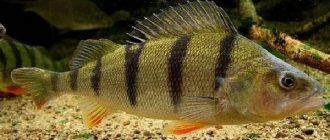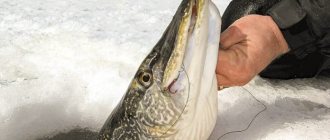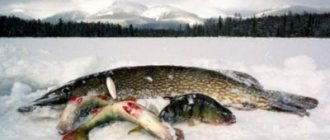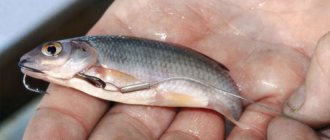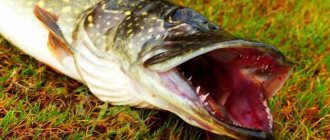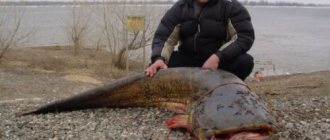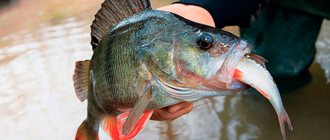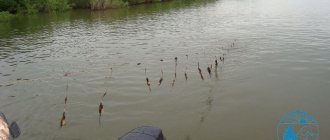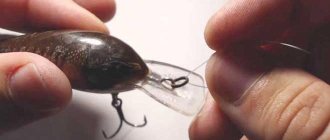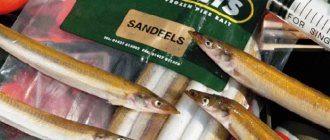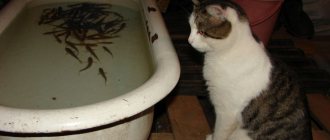Since ancient times, people in Rus' have loved to enjoy dishes made from fish. Some of the most delicious species were considered to be predatory species: pike, burbot, carp, pike perch, and catfish. Having caught a large specimen of such a fish, any fisherman became the envy of other fishermen, and the household members were proud of their earner, anticipating a festive table on this occasion.
However, in order to catch fish of any predatory species, you have to work hard, resorting to various fishing tricks. There are a huge number of ways to “deceive”: a variety of fragrant baits, intricate gear, spinners of various shapes and types. But nothing compares, as an enticement, to live bait, a natural bait for a predator, live bait.
Content
- 1 Live bait in fishing
- 2 Fishing with live bait 2.1 Fish used as live bait
- 2.2 Methods of fishing with live bait 2.2.1 Fishing with a float rod
- 2.2.2 Fishing with live bait
- 2.2.3 Line fishing
- 2.2.4 Fishing from a boat with live bait
- 2.2.5 Other methods of fishing with live bait
Live bait in fishing
Live bait
Nowadays,
live bait
is usually called a small live fish carefully placed on a hook. The size of the bait is an important factor. Despite the fact that pike, for example, is able to swallow prey up to half its length, it usually feeds on fish up to 8-10 cm.
When fishing, the easiest way to keep live bait is in a fine-mesh cage, lowered into the water where there is shade. In cool weather, live bait is usually left in the ditch, periodically refreshing the water.
Unlike live bait, fry
are called fish that do not exceed 40 mm in length. This can be verkhovka, bitterling, bystryanka, minnow, juvenile roach, bleak. If live bait is more suitable for such gear as girders and mugs, then fry is usually used when fishing with a float rod.
Perch, small pike, chub, and ide are readily taken for fry. The fry is usually baited on a single hook by the upper lip or nostril, sometimes by the tail with the tip of the hook pointing out. For river perch that stays with the current, you can use dead fry or its pieces, the so-called cutting.
Our rating of live bait
Crucian carp. The most commonly used live bait in our pike fishing is crucian carp (photo 3) . And, I think, not only with us. Because it is quite easy to get this fish yourself, and in fishing stores crucian carp is found more often than others and is cheaper. But the main thing is that it is difficult for a pike to pick a crucian carp set behind the back due to the dense and bony meat in which the hook sits securely.
I remember one unusual method of catching live bait, which can be adopted during the period of first ice. The pond where I fished for pike during my school years had a fairly large but shallow bay. When frosts began, this bay was the first to be covered with ice. By autumn its depth was less than knee-deep. And it was here, on this shallows, that the crucian carp, the size of an index finger, miraculously survived over the summer, hid from the pike’s teeth.
When the young ice could already support a person, but at the same time sagged and cracked, we came here with axes and cut small holes. After that, we simply stomped between the holes in such a way that water flowed out of them onto the ice. Along with the flow of water, there were also crucian carp on the ice, which had to be collected before they swam back into the hole. The live bait obtained in this unusual way was just enough for several first-ice fishing trips.
And crucian carp are not at all picky about storage conditions. With us, they feel comfortable in a tank of water, even without turning on the aerator. And in the store where we buy live bait, they are generally stored on the shelves of the refrigerator in small plastic containers, and the density of the fish is like that of sprat in cans.
Crucian carp are very tenacious, and when hooked correctly, they remain active for several days. Sometimes crucian carp do not die even after several pike bites - this fish is so resilient! It also happened that after an unsuccessful girder fishing, we removed the failed crucian carp from the gear, brought them home - and they lived quietly for a week or two until the next fishing, even with pierced backs.
In general, crucian carp could be called an ideal live bait, if not for one “but”. Despite the fact that this fish is quite widespread, and it is difficult to find a body of water in which crucian carp is not found, pike are not readily caught with it everywhere. According to our observations, the spotted predator is good at catching crucian carp only soon after the ice has formed, when it begins to eat. In the second half of winter, when the bite becomes noticeably worse, pike respond well to crucian carp only under favorable conditions - for example, during prolonged thaws, when its appetite improves. The rest of the time it is better to offer her another live bait.
Here is an example from last winter. At the end of February - beginning of March, the pike bite in our area is very strongly tied to the evening and morning dawn, when several bites in a row can happen in the deep twilight, but during the day you may not even wait for the flag to rise. Therefore, we use under-ice structures of vents (so-called supply structures), leaving them overnight.
One day we set up our outfits in the bay, where another fisherman had scattered his girders. We used crucian carp as live bait, and in the morning we did not find a single strike. But a neighboring fisherman took several good pikes from his fishing rods that were caught on roach. According to him, he has long noticed that closer to spring the pike almost does not take crucian carp. Therefore, he is not lazy to travel two dozen kilometers to the neighboring Volga Bay, where small roach is caught well. Such time expenditure is fully justified.
And another typical example. That fishing took place on the pond in mid-January. We set up 8 zherlits, loaded them with crucian carp brought from home. The pike didn't take it, and we decided to catch local bait fish. After much torment, we persuaded one palm-sized perch. It was a bit large for a pike, but there was nothing to be done - they baited one girder with it. And it was on this tackle that the only bite that occurred all day was a pike over a kilogram. Alas, it was not possible to catch any more local live bait, and the pike flatly refused to bite on crucian carp.
And one more main disadvantage of crucian carp: despite the fact that the fish remain alive on the hooks of the girders for a long time, they very quickly lose their motor activity - and hang completely motionless on the tackle. Perhaps this is why pike take them poorly? When we fish with crucian carp, we go around the girders from time to time, lightly tugging on the line and forcing the crucian carp to move. Very often, immediately after such rounds, bites occur (photo 4) .
Roach and rudd. The best, in our opinion, live bait, which can be purchased in a store or caught independently in almost any body of water, are roach and rudd. These live baits are often sold mixed in our stores, since they attract pike equally well. They are universal because they seduce spotted predators in almost any body of water. They live on gear for a long time (they don’t fall asleep during one day of fishing), they behave lively and agile.
The pike swallows such runaway soft fish confidently and willingly. They could be called the most suitable for zherlitsa, if not for their poor survivability during storage. It is advisable to catch or purchase such live bait right before fishing, because... storing them at home is associated with certain difficulties. These fish are very demanding of the oxygen content in the water, so they need to change the water much more often than crucian carp - at least twice a day, and the aquarium aerator must be turned on constantly. And during transportation, if the road to the reservoir is long, you need to pump air into the channel from time to time. An ordinary syringe is best suited for this.
Roaches and rudd are the first to be sorted out in stores, and if we were unable to buy such live bait, then having arrived at the reservoir and loading the placed girders with imported crucian carp, the first thing we do is try to catch local roach. Fortunately, these fish, especially small ones, are not very picky about their bite, and are caught almost all winter (photo 5) .
Bleak. Sometimes in stores you can find top melts or bleaks. And sometimes these fish really “shoot” at the pike. But their use is associated with many difficulties that lower bleaks down in the ranking of pike live bait. Firstly, it is difficult to preserve at home. Bleak is a very tender fish. And if roach can at the very least be preserved for up to one week, although this involves a lot of trouble, then bleak can hardly be saved for more than three days. And it’s not a fact that after you have groomed and cherished them, counting the days until fishing, they will not float up belly up in a cramped and stuffy canal on the way to the reservoir.
Secondly, on the hook the bleaks behave very mobile, but they run out of steam too quickly and fall asleep. Therefore, such live baits have to be inspected and changed every 1 - 2 hours. And their third drawback is the softness and tenderness of the flesh, which is why small pike and even perches tear bleaks and topwater fish off the hook with impunity.
If we come across bleaks among the local live bait, then we load a couple of baitfish with them, and sometimes this really gives a positive result. But a couple of years ago, the use of bleaks played a cruel joke on us.
My wife and I planned to leave the girders for the night, but we still couldn’t catch any live bait. We had almost said goodbye to our idea when, in the evening, we came across an old hole with traces of complementary food, where we quickly brought in the required number of small bleaks. We loaded our girders with them, because there was nothing to choose from anyway. And in the morning, when we came to check the gear, we saw that almost all of our fishing rods were unwound, the live bait was either torn off or worn out by perch teeth. Apparently, already at sunset the perch went hunting - and had a great feast on our bleaks...
Guster. In recent years, many small silver bream, half the size of a palm, have bred in our local lakes. We have always considered the silver bream to be a third-class live bait. Firstly, because although she lives on a hook for a long time, she behaves sedentary.
Secondly, the wide shape of its body does not facilitate easy swallowing by pike - and hence the frequent idle bites, when the predator crushes and then throws the bait. The only plus is that the silver bream holds perfectly on the hook: if you pierce it under the dorsal fin, then the predator practically does not manage to rip it off. For a long time we underestimated these live baits, using them only when we were unable to catch roach, rudd, or even bleak. And according to our observations, the pike took worse on the fly. But after a few years, lake pike became so accustomed to feeding on silver bream that they began to ignore all other types of baitfish (photo 6) .
It was here that the rule manifested itself in all its glory that a predator best takes the live bait that constitutes its natural food supply. Therefore, if there are a lot of young silver bream in the reservoir, we safely load our girders with this particular live bait.
Perch. In our opinion, juvenile perch is also an underestimated species of live bait among garrison fishermen. We haven’t seen perches in stores, probably because they are poorly preserved. But on the spot, catching perch the size of your index finger can be quite simple (photo 7) , however, many fishermen neglect such live bait - they believe that pike avoids feeding on perch because of its sharp spines. And in vain! On girder tackle, perch is tenacious and agile.
We have already given an example above, when out of eight girders for the day, only one brought a catch, on which the crucian carp was replaced by local perch. My wife and I had another typical example when our baits were loaded with roaches, but there was no bite. Then we caught small perch, and for variety we loaded some of the girders. It was on these tackles that several bites occurred, and the pikes grabbed the same perches several times, even after the fish no longer showed signs of life. Unfortunately, it is very rare for perches to “shoot” so clearly, but sometimes their use can save fishing.
Fishing with live bait
Fishing with live bait is effective in spring, autumn and winter. Live bait is the best bait for large predators. The food supply of the reservoir becomes depleted at these times of the year and even semi-predatory fish begin to feed.
Fishing with live bait When choosing live bait, you need to proceed from the conditions and time of fishing. The method of fishing determines the depth of fishing - in mid-water, from the bottom, along the top, as well as types of live bait - bottom and upper water. Will there be wiring or not? If we use wiring, then you can use “dead live bait”. Verkhovodny - can be used when fishing from the bottom in snags. Bottom - you can use half-water on a clean bottom, because in snagged and overgrown areas it will simply get tangled. There is an opinion that predatory fish (size does not matter) prefer smaller fish, about 8-9 cm. The species that are much more numerous in a given reservoir should be used.
Most of the large fish bite on narrow-bodied ones: loach, bleak, gudgeon, ruffe, verkhovka and others. Pike, unlike other fish, pays less attention to the width of the body, and catfish can even take on crucian carp, silver bream, and roach. For catching perch, chub, pike perch, the verkhovka is good as live bait. The loach acts as a “test subject” for catching catfish and perch. Char and minnow are suitable for catching perch and pike in bodies of water with no current or low flow. When catching pike, burbot with mugs or bottom tackle, the best is the ruff; when hooked in cold water, it remains alive (mobile) for a long time. Most often, crucian carp (the most affordable) are used for catching grass pike. As for other predatory fish, they take crucian carp only at the moment of intense feeding.
Perch as live bait is used for catching the largest perch, pike, asp, and chub. The gudgeon dies very quickly on the hook, but pike perch, pike, asp, chub, and perch are still caught on it. Roach, on the contrary, is a more tenacious and lively bait. Almost all predators can be caught using it, especially pike. Bleak also catches almost all predators. This is a very movable attachment. Also, for pike, pike perch, and perch, a spined lance (similar to a loach) works well. She is very active and tenacious.
Fish used as live bait
- Verkhovka
. A widespread small fish that can be used when catching most predatory fish. The verkhovka leads a gregarious lifestyle, so it is not difficult to catch it as a wren, using any light-colored food of plant origin as bait. This fish is delicate and, therefore, does not retain activity on the hook for such a long time, and therefore it is hooked directly without removing it from the water, threading the hook through the upper lip, then withdrawing it into the nostril.
- Crucian carp
. As such, it is not a widely used live bait; only pike always take it willingly. This is due to the fact that in densely overgrown rivers and lakes, crucian carp is the most common fish, which is found literally at every step. Pike perch and pike perch, in turn, are not so indiscriminate, which is probably due to the size of the crucian carp.
- Rudd
, once hooked as bait, retains its mobility and vitality for a long time - this is a really good baitfish, the difficulty in its use lies only in the fact that it is not so easy to catch it itself, especially in comparison with a goby or a verkhovna. Rudds are usually caught with a fishing rod using small hooks, but fish caught in this way receive additional injuries, so their value as live bait is somewhat reduced.
- Perch
. It has proven itself especially well when fishing for pike and large perch; it is also known that some anglers often catch not only whole perch, but also parts of it. You can catch perches vertically, equipping the jig with a perch eye or perch fin, since this is how it becomes extremely attractive even for the smallest perches.
- Ruff
. Ruff, as a live bait, enjoys great success with burbot, and the predator grabs it even when it’s dead. So L.P. Sabaneev in his book described what he saw of catching burbot with a ruff tied by the tail with string. Having swallowed such bait, the burbot is no longer able to free itself from it and is removed from the water without problems. Also, it is the ruff that is used more often than other baits when fishing for pike with a wide variety of gear: float, bait and bottom. In winter, this fish is able to maintain its vitality and mobility, sometimes for a whole day or even more. When using ruffe as live bait during fishing, some fishermen trim its spines with scissors, but when catching burbot, this is completely unnecessary.
- Minnow
. The gudgeon is used as live bait everywhere and everywhere; you can catch almost any predatory fish with it. Pike take it well, pike perch loves it, and among other baits, perch definitely won’t miss this one. As we can see, this live bait has many advantages, but there are also disadvantages - the gudgeon is quite gentle and does not tolerate long stays in warm, slow-flowing water. But nevertheless, properly hooked, or even better tied by the gills, the gudgeon, when caught at depth, in cold layers of water, retains its vitality much longer.
- Goby
. Most species of gobies are used in one way or another for catching predatory fish, and they are often caught not only with whole live bait. So, when catching pike perch, you can achieve very good results by attaching the tail of a goby to a large jig.
- The spined lance
is a good baitfish, capable of maintaining its activity and vitality for a long time when hooked. Storing and transporting this fish is not difficult, and catching it is also simple; pinched fish can easily be caught in the most common little fish.
- Loach
. Able to survive even in very oxygen-poor waters. When unfavorable conditions arise, it burrows into the mud for a long time. As a live bait, it enjoys constant success with many bottom-dwelling fish who are very familiar with it. You can catch not only pike and pike perch with it, burbot and catfish are also very fond of it. And it should be noted, with rare exceptions, the loach is almost always taken dead by the pike. This is due to the fact that the loach spins quite a bit, thereby provoking the predator to take a more secure hold.
- Minnow
. In its habitat, you can catch almost all predatory fish with this lively fish; the minnow is especially good when catching grayling, the largest individuals of which prefer this particular baitfish.
Live bait fishing methods
Fishing with a float rod
The float is indispensable when fishing from the shore in heavily overgrown reservoirs.
It can also be used when fishing from a boat. A strong and long fishing rod is used (up to 4-6 meters) with a spinning reel, which can be high-speed or ordinary, with an average gear ratio. It is convenient to catch pike perch with such tackle. Fishing takes place with a leash. For pikes it should be steel.
To attach live bait you will need a single or double (triple) hook. On a single fish, the fish is placed behind a nostril or two lips. A double or triple is passed under the upper fin on the back.
Fishing with live bait
The bait used for fishing with live bait is distinguished by the presence of a removable leash. For pike it should be steel. The leash is connected to a clasp and a swivel. It is attached twenty centimeters above the sinker. For pike fishing, it is better to secure the leash at a distance of one and a half to three meters. The leader is passed through the mouth and gills of the bait.
It is not recommended to use bleak and verkhovka for this method of fishing, which fall asleep almost immediately.
However, they can be secured to the back by inserting a hook under the dorsal fin, thereby extending the period of activity. In this case, you will have to throw the tackle very carefully.
You can fish both in winter and in autumn or spring (in calm water and a depth of up to two meters). If you equip the bait with an additional foam float, the bait will be closer to the surface - increasing the chances of catching a pike or perch.
Fishing by line
In this case, you should decide who it is betting on and choose the appropriate tactics. Bottom placement of the gear will allow you to catch burbot.
In the water column, the line is effective for catching asp, catfish, perch and pike. But the line for catching catfish must be strong and reliable. Live baits are attached to both lips at once for reliability. If you are going to fish in a pond with snags, it is better to use fry. They won't be able to get under the snags. It is preferable to use this tackle on narrow bodies of water.
The leashes are attached at meter intervals. The length of each is up to 60 centimeters. The main line is 0.6 millimeters. And for leashes 0.3-0.4 millimeters in diameter is suitable.
Fishing from a boat with live bait
The use of a boat is justified during the autumn cooling period, when the fish begin to eat. Many fishermen love this fishing method. It puts you in a peaceful mood.
If there is no current, you can use three fishing rods at once (both sides and stern). When moving and on bodies of water with current, two fishing rods are used, attached to the sides of the boat.
Fishing takes place in places with shallower depths. The live bait is located forty centimeters from the bottom. In windy weather or in places with current, it is permissible to use wiring, when the tackle is adjusted by releasing the line from the reel.
Rod length up to 4.5 meters. The reel is taken to be a spinning reel with a capacity of up to 100 m of fishing line (0.20 millimeters). The leash must be used with a swivel to avoid twisting.
During the current, the bait is secured through the upper lip or by threading a leash through the mouth and gills. In calm water, you can thread the hook through the back under the fin. Hooks are used single, double, special triple.
Other methods of fishing with live bait
In addition to the popular methods mentioned, fishermen successfully use it for live bait fishing.
:
- “elastic band” – near reeds and on stretches (throws without jerking!);
- zherlitsa - on small rivers and near the banks (a willow rod is used as a fishing rod);
- mugs - on closed reservoirs (they are a so-called floating girder, disks made of wood or polypropylene).
Basic mistakes when fishing with live bait
- Incorrect selection of live bait (the predator did not like the bait).
- Wrong choice of method for attaching live bait for a specific fishing method and equipment that we use in this case.
- Rare change of live bait. The bait dies and the fish lose interest in it. However, it is worth noting that among fishermen there are many supporters of fishing for dead fish. It is considered a good winter bait.
- Fastening with a single hook behind the back (the bait breaks off).
- Previously, pulling out the tackle prevented the pike from chewing the bait (the predatory fish first tries to kill and turn over the fry and only then swallows the bait!).
Options for attaching live bait to hooks
It is customary to attach live bait to 3 parts of the body. Or behind the back, in this case the hook needs to be threaded under the skin of the upper fin, it is important not to touch the spinal ridge. Or in the head area. In this case, the fish is baited by one or both lips or by the nostril, and the hook is pulled out through the cheek.
Or the live bait is attached in the tail area; in this case, the hook can be passed through the body above the ridge. Or you can hook it on a thread that is tied around the fish’s body.
It is better not to put live bait on hooks that are too large. It is also better not to use very thick leashes. This way, live bait can seriously injure itself while being active in the water.
The type of hooks used depends on the desire of the fisherman. One hook more severely injures a well-moving live bait, while two hooks keep it in a sedentary state. It is better to attach bottom bait fish to your back. It is better to attach live bait behind your back in a weak current. In strong currents, live bait is attached to the head area. There are many ways to attach them to a hook, the main ones are shown in Figure 1-2.
Live bait is placed on single and double hooks on metal leashes, and they also use gear consisting of several hooks. A triple, double or single hook on a steel leash is hooked under the dorsal fin without touching it.
What kind of fish can you catch with live bait?
Live bait is a small, small fish used as bait for catching large predatory fish. In this role, you can use fish of both small species and large fry. They can be caught with a fishing rod, using a fish lifter (a fine net on a frame with a pole), or simply purchased at a fishing store.
Of course, it is best to use live bait from the exact reservoir in which you are going to fish. It is advisable to know the tastes of the type of fish you plan to catch.
With the exception of catfish, fish of predatory species prefer to eat small fish, fry. And only for catfish the size of the prey does not matter.
When choosing candidates for the role of bait, you should remember that the predator prefers a narrow-bodied fish measuring 7-10 cm.
So, bait options for different types of fish:
- Ruff is an excellent option for ice fishing for pike. A very tenacious bait.
- Crucian carp is just as tenacious and good for pike in the warm season. Suitable for fishing in still water.
- Roach - used for catching pike in the presence of a current.
- Gudgeon is an excellent option for asp, chub, perch and pike perch.
- Loach – Catfish and perch adores him.
Ruff
Loach
Carp
Roach
Minnows
Goby
Bleak
Shchipovka
Verkhovodka - Goby is a delicacy for pike perch, perch, and carp.
- Bleak – suitable for any predator. It has a deficiency and dies quickly. Have to change it often.
- Spike is one of the best baits for any predatory fish.
- Verkhovodka is the most common type of live bait. Suitable for pike perch, perch, asp.
Extraction of live bait
You need to fish in shallow waters, in quiet waters on the surface. This is done with the help of a small worm, a landing net, and having previously poured out handfuls of flour waste or bran. The toycat is also called the “spider”. It is made of a metal frame wrapped in nylon mesh with fine mesh. For ease of transportation, the frame is made to be waded.
After assembly, we lower the malyavochnik to the bottom. In this perimeter they scatter bait-porridge, various waste and more. Then, after some time, they sharply raise the fry so that the fry do not “scatter”. You need to lure the fry to the fry in the fall with the help of grass. By stirring up the water, you can catch minnows in shallow water. You need to catch perch using small hooks. The spined loach can be found in shallow water overgrown with filamentous fish. Crucian carp is capricious in the fall, and if it is caught, it is not everywhere.
Live bait storage
Storing live bait It is best to store live bait in a canna with a volume of at least 10-15 liters, made of food-grade plastic, duralumin or stainless steel, and sometimes in a mesh cage with cells of at least 10-12 mm.
In a canna made of ferrous or alloys of non-ferrous metals, fish do not live long. As many holes as possible (10-12 mm in diameter) should be made in the canna cover along the entire perimeter. If you bought the canna in a store, drill additional holes in its lid and increase the diameter of the existing ones. Always keep eland with caught fish at the depth where this type of fish is caught in natural conditions. The canna should be lowered to the bottom smoothly, preferably in a place where the water bloom is minimal. Once water stratification begins, eland with live bait should not be placed in a warm, shallow bay - the live bait will be active there for no more than an hour. If you take it 50 - 100 m, closer to the exit from the bay, then the live bait will last for several days. In cloudy weather with strong winds, the upper layers of water are mixed. This additionally saturates the water with dissolved oxygen, which promotes the activity of baitfish. In this case, eland is raised almost to the surface or used in a floating version. In sunny and windless weather, the eland should always be submerged. It is better to have several plastic, store-bought cannas in stock. They are good because, even when completely filled with water, they are able to float on the surface without additional load. In addition, if you take the storage of live bait seriously, each type of fish should have its own eland.
The permissible number of fish in canna for short-term storage (for one day) depends on the season. From the beginning of the fishing season until mid-June and from the autumn cooling until ice sets in, one fish (weighing 40-50 g) per 1 liter of water is placed in the eland. During the flowering period of water - one fish per 2-3 liters. The vitality of fish is often determined by the time they are caught. Thus, bleaks before and during spawning are very tenacious, but after it they are weakened. Therefore, for example, during the spawning period, up to 15 bleaks can be left in a 10-liter canna overnight (that is, for 3 - 4 hours), whereas after spawning no more than 5 pieces.
When transporting and storing live bait, it is important that:
- The fish were provided with oxygen, for which, as a rule, an aquarium compressor or a simple injector made from an ordinary volleyball chamber is used.
- The water temperature was not subject to sudden changes; it is especially important to monitor this in winter, since fish removed from a cold reservoir and placed in water at room temperature die too quickly.
- Live bait was not immediately placed in tap water after being caught; its properties differ sharply from river water; not all fish survive such stress successfully, with the exception of crucian carp. To replace pond water, you need to add water from the tap gradually, in small portions.
- Regardless of the time of year, live bait was always kept in a cool place, protected from direct sunlight.
- Ruffs were stored separately from fry of other fish species, since during storage, ruffes produce a lot of mucus, which can clog the gills of other live bait in the canoe.
How to catch pike with live bait in the summer
In summer, pike are less active compared to spring and autumn, but do not stop feeding at all. She continues to lead an active lifestyle, usually going to the depths and hiding in the thickets.
In July, the peak of fat comes, the pike lacks oxygen and its activity drops to a minimum. Catching a large specimen at this time is not an easy task. However, a small pike up to 2 kilograms will still willingly bite near the shore.
To find out where the pike is, you need to sit comfortably on the shore and watch for 30-40 minutes. From time to time, schools of small fish will jump out of the water, escaping from the ruthless hunter.
In summer, the best time for pike fishing is early morning or evening, when the heat subsides, in cloudy and rainy weather. Fishing on a sunny day means leaving without a catch.
You can catch pike both from a boat and from the shore.
From the boat
Fishing from a boat is available almost throughout the open water season. Having a watercraft, an angler can explore any body of water and place mugs and summer baits in the most promising places.
About
Fry
Fry
Fry are small fish up to 40 mm long. The fry are caught with special fine-mesh nets—baby nets, lowered to the bottom with bait made from bread crusts. The fry are caught in shallow water, near the shore, where they swim in large flocks on fine mornings, when the water here warms up faster. Fry are stored and transported in the same way as live bait, but taking into account the fact that the former require more careful and gentle handling. The fry are not stored for future use.
The fry can be transported over short distances in plastic bags filled with water, or directly when fishing - placed in wet moss.
The fry are baited by the lips or nostrils, and in calm water, hooked by the back, they swim well.
In the fall, perch and small pike are caught on fry, but other fish can also be caught. Fished with a float rod.
